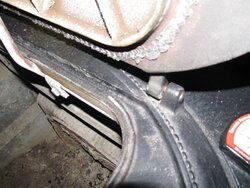I vaguely remember a thread where a prominent member of the forum stated that Woodstock missed the opportunity with the Progress to create a long and level burning catalytic stove. I took exception to the comment at the time, but living with these two stoves 24/7 in the same house for the last three seasons (was early to the Progress party), I have become more sympathetic to that comment.
A little bit of perspective may be helpful before I answer your specifically. I have owned and burned that Firelight 12 since 1998 (16 seasons!) and feel like I have a pretty good handle on it. It sits at one end of the house in a large, open area. The Progress sits at the other end of the house, in a similarly sized room. Chimneys are both external, masonry and of similar height, flue size, etc. Both chimneys draw well. I burn red and silver maple and oak with some spruce mixed in for good measure (love the smell, gets the fire going quickly and with a great snap, crackle and pop). But I digress... The stoves are fed identical diets of this wood, which is appropriately seasoned and checked occasionally with a MM to verify. We live in coastal Maine where winter temps tend to be consistently cold, but generally not extreme as air temperatures are moderated by the ocean (we live at the end of a long peninsula). Winds can be fierce and occasionally result in drafts that feel like they'll pull your hair out and as a consequence, both stoves have in-line dampers solely for use on those occasions. These stoves are our primary source of heat from October through March and occasionally into April.
Having given you the general conditions under which each stove is operated, there is no question in my mind that the Firelight is, for us, a far superior stove in every respect. As you are aware, Joful, the Jotul is a top loader and exceedingly easy to load and with a larger useful firebox than the Progress. You can really load that Jotul to the top. I'm easily getting two to three hour longer burn times (useful heat output) than with the Progress at my "normal" overnight settings on the stoves and that is almost always with soft maple in the mix. With 100% oak, the difference in burn times is even more pronounced, but I don't need to run them that way so it's a rarity that I do (extreme cold conditions). Clearly, some of that extra burn time is firebox capacity. But the bigger and more significant difference is controlability of heat output. The Progress has a very strong early peak in heat output and then tapers from there. I think that it fully lives up to it's billing as a "hybrid" in that regard. The peak is a little less pronounced than with a 2ndary burn stove (owned several of them), but nowhere near the much more level heat output of any cat stove I've run. The practical result of this is that the house temperatures vary more with the Progress and it requires more tending to try to level out the heat output. BTW: I am now (once again) using a ceramic cat from Condar in the Jotul and am very pleased with its performance. Anecdotally, I do feel like the Jotul is more efficient at converting potential btus into actual btus - just seem to get more heat out of it... the dogs would agree with that based on which stove they prefer to lay next to.
In addition, there is no (ridiculous) screen to clean in the Jotul. The Progress requires a full stove shut down for me every 3-4 weeks as that screen becomes sufficiently plugged to create problematic draft issues. Plus, the process for removal and replacement of that screen is real irritant, especially compared to the Jotul. I remove the plate covering the cat in the Jotul once at the end of the burning season, pull the cat out and there's almost never any ash in it! Perhaps I find the Woodstock so irritating just because I have the Jotul at the other end of the house laughing at me while I wrestle with putting the screen back in (yes, I have updated the screen twice now and have the very latest screen and assembly). This is a major drawback for this 24/7 3 season burner who has better things to do.
Both stoves have excellent ash drawers which have good capacity and easy operation (internal grate systems). Not a part has failed in 16 years of burning the Jotul. I have replaced the top loading gasket 3 times and the cat 3 times. That's it. I replaced the top loading lid gasket the right way (not on the lid), too ;-) I have the green porcelain finish and it's as flawless as the day I bought the stove. The Woodstock hasn't had any meaningful problems but has been subject to numerous parts updates or recalls (top stones, cat screen, cat). Woodstock has delivered excellent customer service on numerous occasions where I've needed it. Jotul? I don't have a clue, I've never needed any customer service.
Lest you think that I'm (manufacturer or material) biased, I am now running a Woodstock Keystone in our cottage and I think it's every bit the stove that the Jotul is, albeit in a much smaller package. I'm getting 9 hour burns on the "1" setting with red maple with outstanding heat level controllability. Gotta love those cats! We're building a new house in the area and I already have that mahogany porcelain Ashford ready to go, but I'll miss the Jotul's ash drawer. If Jotul still made the 12, I'd have bought that instead of the Ashford...




